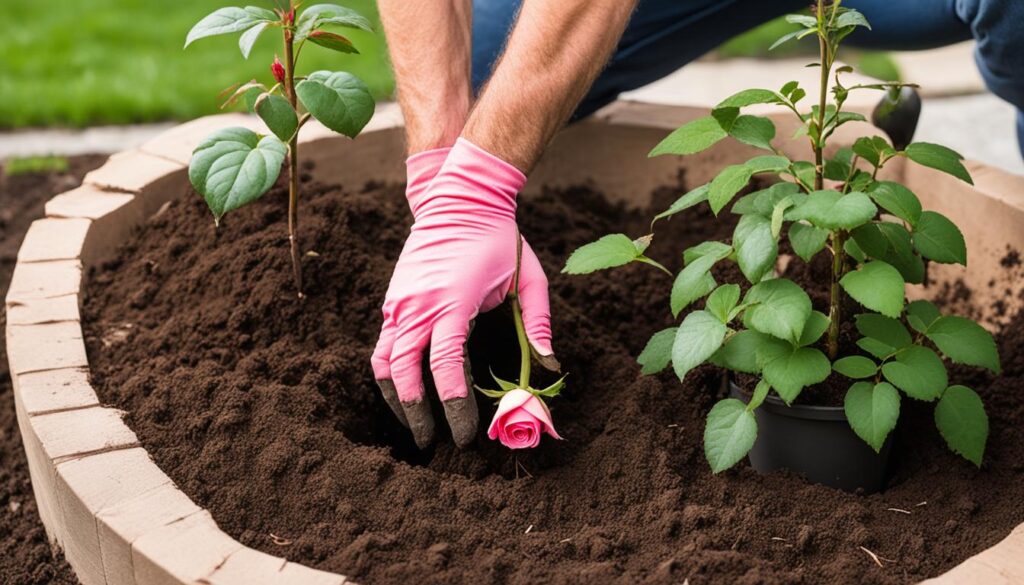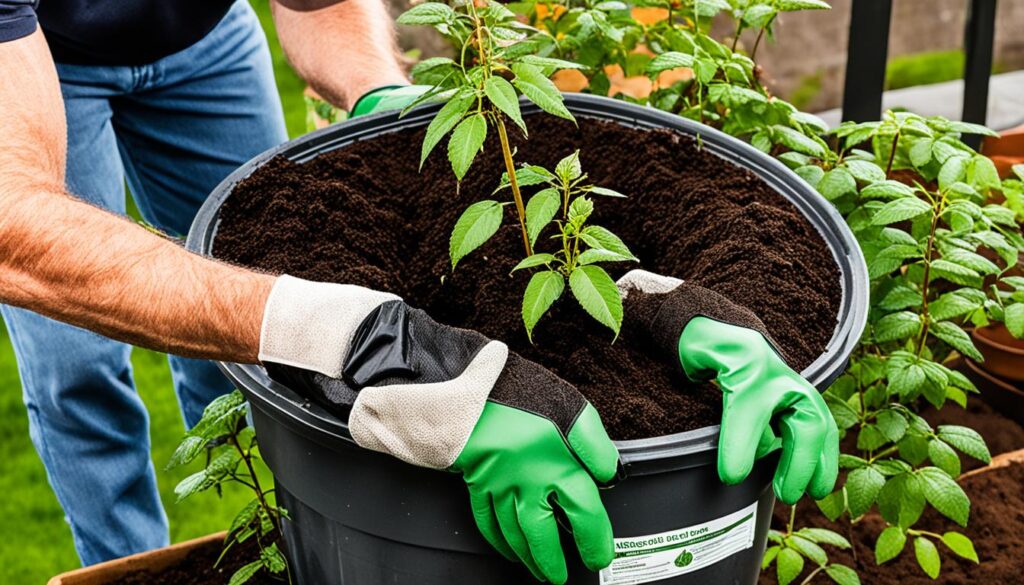Ever thought about turning your yard into a stunning place with bushy roses? Picture your rose bushes starting to bloom. Can you imagine your landscape turning into a flowery wonderland? It’s easy to create such beauty with just a few steps.
Growing rose varieties in containers isn’t hard. It’s about picking the right ones that will blossom without a lot of care. Ready to learn the secrets to planting bushy roses in a pot? Let’s look at how to give your 2-Quart potted shrub rose the best beginning.
Introduction to Planting Potted Bushy Roses
Growing bushy roses in containers has many benefits. It’s great for small spaces like decks or patios. With potted roses, you can better control the soil, water, and sunlight they get. This is a big help if the soil in your area isn’t the best for roses.
Benefits of Growing Bushy Roses in Containers
Growing shrub roses and miniature roses in pots is advantageous. They are easier to take care of. You can watch how much water and food they get. Also, pots can protect them from some pests and diseases.
Types of Roses Suitable for Potted Growth
Not all roses are good for containers, but some are perfect for it. Bushy roses, like English and Shrub Roses, do well in pots. They are small and bushy. So they fit nicely in planters. Miniature roses and patio roses are also great for pots. They are small by nature.
Choosing the Right Container for bushy roses
When you grow bushy roses in a pot, pick a big and tall one. It should be at least 15 inches wide. This is because roses need deep pots for their roots. The height matters too, giving the roots enough room.
Pot Size and Material
The size and material of your pot affect how well your roses grow. Clay pots are better than plastic. They keep the soil cooler by not trapping as much heat from the sun. For plastic, choose a light color to keep the heat away. This protects the roots from stress.
Drainage Requirements
Having good drainage is key for container roses. A pot with lots of holes at the bottom stops too much water from sitting around. Too much water can cause root rot and harm the plant. Good drainage keeps the soil from being waterlogged, which means more oxygen for the roots to stay healthy.
Choose the right size and material for your pot and make sure it drains well. This will help your bushy roses grow happily, giving you lots of lovely flowers.
Preparing the Potting Soil Mix
When planting roses in pots, it’s crucial to get the soil mix right. The soil needs to drain well but also keep enough water. For a perfect mix, use one-third each of top-quality potting soil, garden compost, and composted manure. Put a cup of perlite in for better drainage. To feed your roses, add one cup of bonemeal for essential nutrients. You can include fishmeal or blood meal too, but don’t use too much fertilizer. Overdoing it can harm your plants.
Essential Ingredients for Rose Potting Mix
The secret to a good rose potting mix is using materials that help with drainage, nutrients, and keep water. Start with high-quality potting soil. Then mix in garden compost and composted manure for organic matter and nutrients.
Enhancing Drainage and Nutrient Content
For better soil, add perlite. Perlite is great for drainage and making sure there’s enough air for the roots. You’ll also want to include a cup of bonemeal. It brings in important nutrients like phosphorus and calcium that roses love. A bit of fishmeal or blood meal can be good too, but remember, don’t use too much fertilizer.
Planting Potted Bushy Roses Step-by-Step
To plant a bushy rose from a pot, start by filling your container most of the way with soil. If it’s a bare root rose, put soil in the middle before placing the plant. Then, spread the roots out. For a rose already in a pot, make a little hole in the soil. Take the rose out gently, making sure to loosen any tight roots.
Removing Plant from Nursery Container
Put the rose in the pot’s center and add more soil around it. Press this soil firmly. You want the surface to be just below the bud union.
Positioning and Planting Depth
Water the plant well right after planting. Then, only water when the top of the soil is dry. Make sure to keep the leaves dry when watering.
Watering Techniques
Good watering is key for a rose to grow well after being moved. With these easy steps, your potted bushy rose will have a great beginning.

Selecting the Ideal Location for Potted bushy roses
To help your potted bushy roses do well, they need plenty of direct sun exposure. Place them where they get seven or more hours of sunlight every day. On porches or decks, you might have to move the pots to keep them sunny.
If you have many potted roses, make sure they’re at least 2 feet away from each other. This ensures they get enough air circulation. Good air flow stops diseases like powdery mildew.
When you think about where to put your bushy roses, focus on the sun and air they need. Doing this sets your potted roses up for the best chance to grow and flower well.
Watering Needs for Container-Grown Roses
Potted roses need more water than those in the ground. If the top soil inch is dry, then it’s time to water. Always aim for moist soil, not soaked. Don’t water between 10 a.m. and 6 p.m., when it’s hottest. This is because water evaporates quickly.
Frequency and Timing of Watering
It’s important to keep the rose leaves dry to prevent disease. Drip irrigation systems are perfect for this. They water the plant’s roots only, keeping the leaves dry. This setup also helps manage soil moisture better and stops diseases.
Avoiding Wet Foliage
Learning the correct care for potted roses is key. This knowledge keeps your roses thriving and disease-free all season.
Fertilizing Potted bushy roses
Roses in pots need more food because they use up soil nutrients faster. Use a balanced rose fertilizer every two weeks to keep your potted bushy roses thriving with essential nutrients. It’s important to not overdo it; follow the fertilizer’s guidelines carefully. Always put the fertilizer into the soil, not on the leaves, to avoid damage.
Balanced Rose Fertilizers
A good rose fertilizer should have everything your container gardening roses need. This includes nitrogen, phosphorus, and potassium, along with other nutrients. These elements help your roses grow strong, bloom beautifully, and stay healthy.
Adjusting Fertilization Schedule
Dial back on fertilizing eight weeks before the first winter frost to protect your potted bushy roses. This step avoids new growth that can be hurt by the cold. By tweaking your nutrient management, you ensure your roses will do well over winter and bloom healthy next spring.
Repotting and Soil Renewal
Most potted roses need to be repotted every two to three years. They use up nutrients in the potting soil fast. You’ll know it’s time to repot when you see stunted growth, wilting, or roots out of the drainage holes.
When repotting, make sure to use new potting soil. Take the rose out of its pot. Gently loosen tight roots. Then, replant in a bigger pot. This helps avoid salt and mineral problems that harm the plant.
Signs for Repotting Potted Roses
It’s important to spot the signs your roses need repotting. Watch for:
- Stunted growth or lack of vigorous new cane development
- Wilting foliage, even when the soil is adequately moist
- Roots growing out of the drainage holes in the pot
Proper Repotting Techniques
Here’s what to do when you need to repot your roses:
- Get a new, slightly bigger pot ready.
- Add good potting soil at the bottom.
- Take the rose out gently. Loosen tight roots.
- Put the rose in the new pot. Add soil around it.
- Water it well to settle the soil.
Following these steps will give your roses a great start in their new pot. They will bloom beautifully season after season.

Overwintering Strategies for Potted bushy roses
It’s important to keep potted overwintering potted roses safe from the winter’s bad weather. Since they’re in pots, they’re more at risk from the cold than ground-planted ones. To help your bushy roses survive the winter, here are some top winter protection tips.
Mulching and Insulating Containers
Mulching the base of your potted bushy roses is an easy step. Put down a 4-6 inch layer of something like shredded bark or leaves. This keeps the roots warm and stable against big changes in temperature.
Using Cold Frames or Hoop Houses
For even better protection, you could use a cold frame or hoop house. These structures make a small area that’s warmer and keeps out wind and frost. They’re great for areas with very cold, snowy winters.
Bringing Potted Roses Indoors
For those with space, bringing potted bushy roses inside is the safest choice. Put them in a cool, bright spot like a garage or basement. This keeps them safe and allows them to rest until the spring.
Pest and Disease Management
Potted roses face many of the same threats as garden roses. The main bug problem is aphids. They suck juice from buds and leaves. This makes these parts wither. Using a garden hose to wash them off or picking them by hand works well.
Common Insect Pests on Potted Roses
Rose pests, especially aphids, can harm potted roses fast. It’s important to check your plants often. If you spot aphids, remove them quickly. This keeps your roses healthy.
Preventing and Treating Fungal Diseases
Rose diseases like powdery mildew and black spot can affect potted roses too. The best way to fight these fungal diseases is to prevent them. Good air flow around the plants is key. This makes sure the leaves stay dry. If fungal diseases show up, there are special medicines you can use. They help your container-grown roses get well again.



